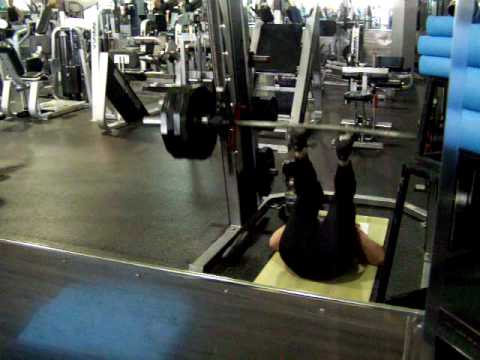A few months ago I wrote a post on warming up for those with a chronically overextended lumbar spine. Since then I’ve gotten a few requests for a sequel post, so... Without further adieu…
For the Overextended Part II: The Lift
In my first post I discussed “prepping” for the lift for those with exaggerated lordosis. I babbled about targeted stretching, mobilizing, and activation exercises used in conjunction with the idea that it would help “tuck” the hips under a bit more and reduce that ridiculous curve in the lower back that ails us.
For many that'll do the trick. After the warm-up they can feel their abs and glutes engage a bit more throughout their lifting session and they feel much more secure about their lower back health.
However, there are those that need more than a 15 minute warm-up to relieve them of their discomfort caused by the overextension. These might be the people with hip flexors that refuse to let go, erectors in constant spasm, and glutes that seem to have tragically passed away from years of desk work.
For these people with symptoms a bit more severe than the rest, some careful consideration should be taken into not only their warm-up but the structure of the lifting program itself. Here are a few exercises I like to use to fight against the overextension apocalypse.
Lower Body
Front Squats
For improved posture I tend to favor front squats over back squats mainly because it really helps to emphasize t-spine extension. Like I mentioned in my previous post, a hyperlordodic posture is often accompanied by significant kyphosis in the upper back. By focusing on keeping the upper back tight and the elbows up and in, front squats basically become a good way to practice good posture under resistance. (Practice makes permanent!)
Split Squats
Remember to do your split squats with all of the knee health rules in mind (keep the knee tracking straight ahead, try to keep a vertical shin), but add this one: squeeze the glute of your rear leg HARD the entire time. If you really flex that rear buttcheek you will feel a good stretch in that hip flexor as you descend to the bottom position.
Pull-Throughs and Glute Bridges
Keep hammering away at your posterior chain strength and emphasize the “tuck under” with your hips. Pull-throughs with a band or cable column is a great way to train the backside while avoiding any compression on your spine. Also throw in some glute bridges into your actual lift! They shouldn’t be reserved for just the warm-up.
Glute bridging variations are endless:
-Double Leg -Single Leg -Double Leg Concentric with Single Leg Eccentric -With a Barbell -With Chains -With a Barbell AND Chains -Back Elevated -Feet Elevated -Back AND Feet Elevated
Get to 'em!
KB Swings
Same idea as above: POSTERIOR CHAIN WORK. Perfect the hinge and develop incredible hip thrusting power. I recommend getting Kelsey or another well-qualified coach to supervise if you haven’t done them before. A correctly performed swing session can do wonders for your posture, but a bad swing sesh can wreak havoc on your lower back!
Upper Body
½ Kneeling Work
Do standing overhead presses and barbell rows make your lower back cranky? Fear not, and enter the ½ kneeling realm of pushing and pulling. Getting into the ½ kneeling position does a great job of positioning overextended spines back to neutral. Replace some of your pressing movements with single arm ½ kneeling landmine, kettlebell, or dumbbell presses. Then make sure to get your pulling in and grab a band or a cable column to do some ½ kneeling rows as well.
Push-Ups and Inverted Rows
Easy enough right? If you take away the movement from the upper extremities, these exercises become a plank or an isometric glute bridge, respectively. What I mean by that is you MUST make sure you keep your abs tight and your hips (NOT lower back) locked in extension as you do your push-ups and rows. When you feel like you’re starting to arch, call it a set or reset your hips.
Benching…?
Bench pressing can help improve my overextended posture?! No, I doubt it. However, I’m throwing it on here for a couple reasons 1) A lot of us are probably going to bench anyway. 2) It may be part of your team’s strength program for high school, college, or beyond.
Many trainees (including myself) prefer to bench with an arch. It helps to get into a position of better leverage and feels a bit smoother on the shoulders. When setting up to bench with a significant arch there is going to be some extension in the lower back, but you should try your best to emphasize the arch coming from the thoracic spine. If you cannot get into an arched back position on the bench without discomfort you still have options. You can simply bench with less of an arch, and by elevating your feet on weight plates you will be able to get a flatter back posture more comfortably. Another option you have is... don't bench. What?!
Floor Press
Take it to the floor! Bring your feet in and keep your back flat against the ground. That should quench your thirst for supine barbell pressing.
Anterior Core Work
Always throw in some work for your abs. Stronger abs will help pull that pelvis up in the front and decrease that anterior tilt. Anti-rotation presses, reverse crunches, roll-outs with a stability ball or an ab-wheel, and stir-the pots are all good options. One of my favorites is a plank. Boring you say? Load it up! Start stacking plates on your back and try to PR every time.
Fin That’s it for now. Can’t guarantee a part III, but you never know!



